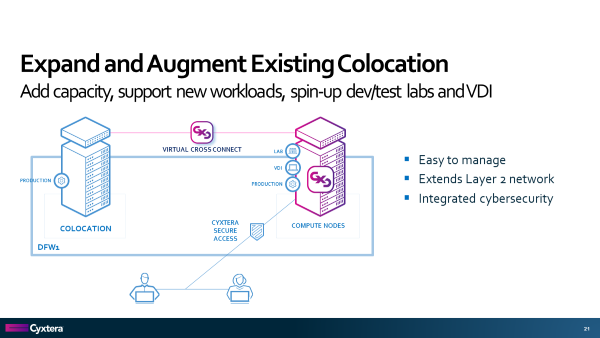How to Gain the Benefits of Dedicated Infrastructure, in a Cloud-like Model
Hybrid IT, Connectivity, Marketplace in Data Centers
In the previous third part of this series we discussed our CXD Unified Services port, which enables on-demand connectivity to our Cyxtera Extensible Data Center (CXD) platform.
Part four looks at our hyperconverged infrastructure (HCI) offering, CXD Compute Nodes. Compute Nodes provide all of the benefits of dedicated infrastructure delivered in a cloud-like consumption model.
While cloud infrastructure as a service (IaaS) offerings provide great flexibility in how and where you deploy, running traditional database, VDI, and CPU or RAM heavy VMs on IaaS is often not cost effective. It can result in compromises in resource allocation that can impact your end users.
Cyxtera’s Compute Nodes leverage Nutanix HCI software to provide a robust and extensible hypervisor agnostic HCI platform. Compute Nodes are delivered over our CXD programmable network platform. This allows for rapid and flexible deployment of virtual machines, containers, and disaster recovery workloads with a monthly fee for compute and storage. The consumption-based model avoids the need to build to peak load, buying capacity as your demand grows.
Deploying virtualized infrastructure in a new or existing colocation facility can be a time consuming and costly process. Using our CXD Command Center you can deploy Nutanix clusters of any size, VLANs, and CXD IP Connect internet connectivity either programmatically using APIs or through a browser in a day.

Since Compute Nodes utilize Nutanix software, you can use your existing hypervisor of choice, VMware ESX, Microsoft Hyper-V. If your application is not dependent on a specific hypervisor Nutanix AHV is a KVM based hypervisor that is included with the service and requires no additional licensing fees or software to fully control your cluster.
Compute Nodes are available in several configuration options with storage options of all flash or flash and traditional hard drive hybrid mix. The models available allow you to tailor the storage mix to your specific workload requirements. It provides inline compression, deduplication, multiple levels of redundancy to protect from multiple drive failures, and with an additional licensing provides data at rest encryption for the entire cluster. Once created the cluster can be accessed directly over layer 2 VLANs from your colocation environment in the same metro region via a CXD port, with a circuit from a traditional telco, or an IPSEC VPN using a virtual router or firewall.
Now you can create and run as many VMs as possible given the resources on your Compute Node cluster, without the variable costs of a public cloud or the capital expenditure of standing up your own devices in colocation. It saves weeks of time compared to using your own resources to configure the colocation environment.
Views and opinions expressed in our blog posts are those of the employees who made them and do not necessarily reflect the views of the Company. A reader should not unduly rely on any statements made therein.

Share this Post